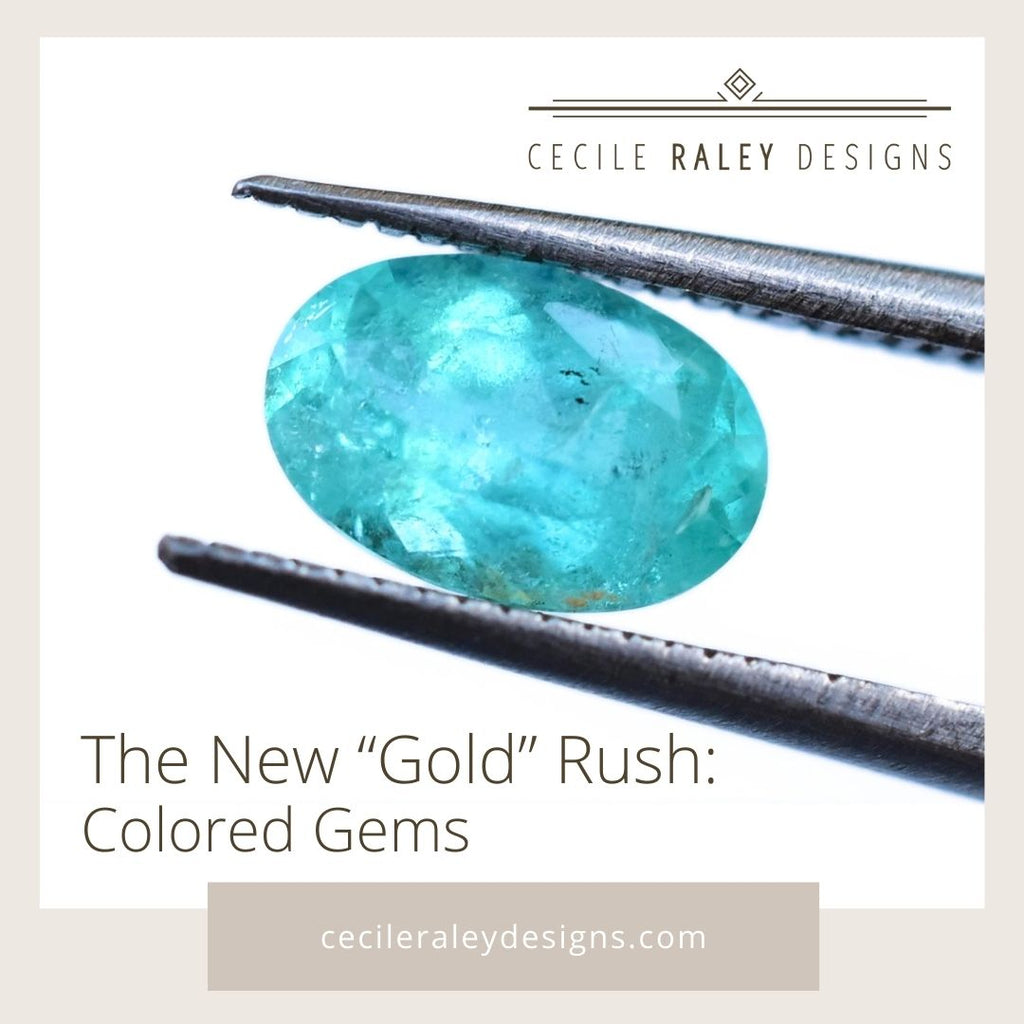Knowing When to Sell Your Colored Gemstones (& When to Wait!)
A couple of months ago I asked one of my gem sellers if I could "memo" (i.e. the jewelry trade practice of borrowing) his 1.07ct Benitoite that he had just acquired, and list it in my shop for sale. “No,” he said, firmly. “Because it will accrue value faster than inflation, so it’s better for me not to sell it right now.” Better than an 8% annual inflation? Yes, better than that. And he’s right (too bad for me but a smart move).
In Tucson 2022, the first Tucson with a sizable show of international vendors, I spent just about every penny I had in the bank. And then I did something crazy: I put many of those gems in a box, for later, even though I was flat broke! I also locked in several payment plans for merchandise so I could avoid paying more for the same stuff a few months later. To do this, I used up the “street cred” I had built up with them over the last decade or so. I’ve had to pay some purchases off very slowly, but my vendors know that in the end, I am reliable, and if they needed a little extra cash or I needed to stretch things, we could up or down the payments as needed. The basis of such deals is a lot of trust, but that goes both ways as I also trust my suppliers to be honest about their goods and current pricing.
In the past few years, I've had several clients tell me that they'd rather save up and wait to buy a larger Paraiba (or other gem, but mainly Paraiba) at a higher price, but that strategy has backfired; unless they save very quickly, inflation will outpace them. As a gem seller it's tough to tell people "please buy now and find a way to finance on your own, it is better for you" and not sound like I'm giving a sales pitch. But I will say that the last few years have borne out my predictions.

It’s been a tough 2022 sales wise but I am happy with what I own and not worried that I will get stuck with my gems. The Paraibas have already accrued over 20% since I bought them in February, and while the trend may level off, I am certain they will never go down. Other gems, like my powder blue cobalt spinels (and a few deeper ones I have), will accrue more slowly, but they have already exceeded blue sapphires of the same color in value. My 2.2ct blue Burma sapphire has already doubled in price since I got it in 2020. My emeralds are up 30% since the same time.

I did sell all my Benitoites, unfortunately. Should have saved those too, lol. Instead, I took one of my red spinels off of the website because I realized that it had been there since 2019 and the price was now too low. While I am happy to pass good purchases on at a discount, there is such a thing as feeling that the value of an item has not been fully appreciated. So now I get to enjoy the spinel myself until I feel it may be time to put it back out there. In the meantime, this is a good opportunity to get it certified – not something that’s needed for most spinels because they have no known treatment, but I do recognize that many novice buyers feel reassured by this (whereas any buyer should certify origin and treatment of any sapphire of value). My two rubies on Etsy, meanwhile, are quite reasonably priced at this point but I’m leaving them up for sale as my heart beats faster for spinel than ruby. And I am, after all, a gem seller, not a gem hoarder! :)

(Entertaining side note: Pantone just named “Viva Magenta” – 18-1750 – to be the color of the year 2023, and of course the AGTA followed suit, wanting to market gems of that color to promote sales of Magenta colored gems. But what gems are those??? Magenta colored Mahenges are completely wiped off the market, Magenta Burma spinel practically sold out, and ruby doesn’t have that color, it’s more red. That leaves a few not easy to come by Magenta red tourmaline as the only option. Am I wrong about that? Do you think that pink sapphires or some rubies are 18-1750 or rather a different tone? Let me know, I am drawing a blank, and I love that color.).

But I digress. Let me pass on another anecdote. One of my old friends in the trade, Jaimeen Shah from Prima Gems, once said to me that you can measure the health of a gem business by how long it can hold on to merchandise. If a seller needs to flip gems for immediate cash, then the business is in bad shape. If he or she can afford to hang on to their stock for over a year and be blasé about making the sale, then they are doing very well. A healthy business might keep stuff in the safe for decades. They might even put higher price tags on their gems and then just shrug their shoulders if you ask for “their best price,” telling you that they don’t care if you can’t buy it at the full asking price. They figure that sooner or later, it will sell, and they are right. (Asking for the best price is a practice that many of us find rude – a healthy business is not desperate to make a buck).
If you enjoy buying gems but also enjoy selling and trading, don’t fret if things aren’t moving right now. And don’t get desperate. Give it time. While there are gems that really never have much value – iolite and apatite come to mind – the sheer rising of labor costs over the last half decade have even made those more expensive than they used to be. You may remember for example that back in 2010, you could buy cheap citrine and amethyst for $1/ct wholesale, and those days are long gone despite the fact that the vast availability of both gems has not changed one bit.
Remember that as the public gets educated, colored gems will become more and more of an alternative to diamonds. This is a good thing for you if you already own some colored gems because while white diamond supply (for jewelry) is virtually endless, this is not the case for most colored stones. Not just for the short lists of examples you find online, but really it’s true for most of them, even the non-spectacular. The exception I want to hedge over is quartz, and if you throw in bead quality gems the situation might be different. Rubies, sapphires, emeralds, any spinel, any zircon, any apatite, peridot and iolite even, are rarer than diamonds. They are just not all super pretty or sparkly or super hard and durable. They are also not carefully controlled and cultivated.

Already one can see the influence of clever marketing strategies affecting colored stone pricing on the commercial market. Padparadscha sapphire and aquamarine come to mind, and blue sapphire, as we find European royalty and international movie stars flaunting their colored stone engagement and anniversary rings. Before 2014, lighter to even medium colored aquamarine traded at $5-15 a carat. Now they are at $35, and larger specimens are $100/ct and up in the trade. In Madagascar, prices of aquamarine went up by a factor of five in the last six years.

It should be noted that aquamarine, especially fine goods, were fairly underpriced given their availability, at least in my view. Maybe that’s because the lower quality goods are very light colored and sort of, well, boring looking. Prices of color change garnet have gone up similarly – and those don’t look boring to me at all. I don’t mean the ones that just lightly shift “hues” like from pinkish to purplish, but the ones that shift from teal blue-green or grey blue-green to purple, or a strong pink to a strong purple. Lindi (Tanzania) appears to be mined out, and Bekili (Madagascar) is right now difficult to come by and difficult to export.

The upshot: if you own some finer quality gems, reasonably well cut, low on inclusions, pretty, and let’s just say to be on the safe side, not quartz, then I think you can expect a continuing increase in value. Granted it is harder to resell for a retail buyer, but whatever you paid whenever you paid it, expect it to be at a higher price now. And this is NOT the case for your engagement white diamond which loses 10-20% of its value as soon as you leave the store with it (one last note on that: untreated colored diamonds, especially pinks, reds, peach, blue, natural grey, purple, green, have skyrocketed in the last 20 years. Pink diamonds have doubled in just the last two years, one of my vendors told me. So those are not to be compared to white, which are up right now because of supply chain issues but will come back down when that is resolved. Remember that Russia is a huge supplier of white diamonds and right now we are not buying anything from Russia.

I’ll end this blog with a quote from an overseas vendor that was part of a conversation literally today, when I told him that this year has been slow (something everyone in the trade is saying): “Good stones in the safe are not going anywhere… nor is their value.”













